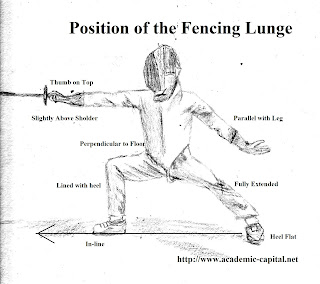The fencing flick is a move that would likely make the
traditionalists cringe when seeing it in tournament. The action is so quick fencers
have a hard time formulating a proper defense. It is not generally taught at the
college level under traditional curriculum and came into existence after the
invention of the electronic fencing sword. Because it is not widely known or
taught it can be a powerful tool to overcoming an opponent’s defenses.
The flick occurs when an attacker moves his arm and foil to
hit his opponent but just before full extension flicks his wrist making the
blade swish. Since the foil is long and slim it has the ability of bend and
creating a wrapping action. This fly fishing motion causes the tip to bend
allowing it to hit the opponent on the back or shoulder. Such an attack may
also work on the front but is most commonly as a way of throwing your opponent
out of balance.
The defense against a flick often includes using a modified
sabre quinte (90 degrees from the axis of the body) and a ducking motion. The
other method includes a parry 10 which is exercised moving the blade so that it
runs just above your shoulder to the point behind the head to deflect the
attack. Immediately the fencer should swirl the sword to try and obtain a
strike on your opponent to create a fluid defense and attack motion.
Another method of countering the flick is to close the gap
of distance between you and the opponent. When this gap is narrowed the opponent’s
tip of the blade will be off target allowing for a possible strike of the
opponents body. Such a move comes with a price. Once you are close to your
opponent and miss your initial attack there will be a furry of effort in order
to strike each other. This madness of motion can be a frenzy of attack and
parry that speeds up the game.
The flick is considered an intermediary move that should be
learned after the basics have been mastered. Traditional instructors do not
have any particular fondness for the flick as it doesn’t fit within the
historical context of fencing.
In true life it would not likely cause much
damage as the point of the blade is more like a touch than a stab. However, it
does count in the sport of fencing as the right-of-way is claimed once the arm
moves forward and the opponent is forced to parry. It takes practice and the
right equipment to do the flick well. Some foil blades have additional
flexibility that isn’t found in heavy steel.


